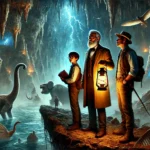20,000 Leagues Under the Sea is a classic science fiction adventure by Jules Verne, one of the pioneering figures of the genre. Published in 1870, the novel takes readers on an extraordinary underwater journey aboard the enigmatic submarine Nautilus, captained by the mysterious and philosophical Captain Nemo. The novel blends thrilling adventure with scientific exploration, touching on themes of human ingenuity, the power of nature, and isolation. It remains one of Verne’s most celebrated works and continues to inspire modern science fiction.
Plot Summary
The year was 1866, and an inexplicable mystery gripped the world’s seas. Ships across the globe reported sightings of a massive, unidentified creature, larger and faster than any whale known to man. Whispers of this strange being circulated from the bustling ports of America to the quiet docks of Europe, sparking fear and fascination in equal measure. Some claimed it was a massive sea monster; others speculated it was an enormous submarine of unknown origin. But one thing was certain: it existed, and it was causing havoc in the maritime world.
In the midst of this chaos, the United States government commissioned an expedition to hunt down this mysterious creature. Aboard the warship Abraham Lincoln, a crew of sailors, scientists, and experts set out to confront whatever lurked in the deep. Among them was Professor Pierre Aronnax, a respected marine biologist, who was as curious about the creature as he was determined to study it. Accompanying him was his loyal servant, Conseil, and a master harpooner named Ned Land, known for his skill in capturing the largest of sea creatures.
Days turned into weeks as the crew scoured the oceans in search of the elusive beast. Just when their hopes began to wane, the creature appeared—an immense, glowing form beneath the waves, faster than any ship. The Abraham Lincoln gave chase, and in the chaos that followed, the ship collided with the beast, throwing Aronnax, Conseil, and Ned Land into the ocean.
Clinging to the wreckage, the three men feared for their lives, but fate had other plans. As they drifted in the cold waters, they found themselves upon the very creature they had been hunting. To their astonishment, it was no living being, but an advanced submarine—a technological marvel far beyond anything known to the world. They were rescued and brought aboard by the crew of this vessel, the Nautilus, commanded by the enigmatic Captain Nemo.
Captain Nemo was unlike any man they had ever met. A brilliant but troubled figure, Nemo had turned his back on the surface world, choosing to live in the depths of the ocean. He harbored deep resentment towards the nations of the world, especially their imperialistic and oppressive systems. His submarine, the Nautilus, was his refuge, a place where he could live free from the influence of any government or society. Nemo offered Aronnax, Conseil, and Ned a choice: they could remain aboard the Nautilus as his guests, free to explore the wonders of the sea, but they could never return to the surface world.
Faced with little choice, the trio agreed, and thus began their extraordinary journey under the waves. For months, they traveled across the globe, from the coral gardens of the Indian Ocean to the sunken ruins of Atlantis. The Nautilus took them to places that no human had ever seen, allowing them to witness the beauty and danger of the ocean depths. Aronnax, in particular, was fascinated by the scientific discoveries, cataloging the creatures they encountered and marveling at the technological genius of the Nautilus. The submarine itself was a masterpiece, powered by advanced electric engines and capable of navigating the ocean’s darkest depths.
But not all was peaceful beneath the waves. The ocean, as beautiful as it was, also held many dangers. The crew of the Nautilus faced deadly encounters with giant squids, treacherous whirlpools, and attacks from hostile ships. Yet through it all, Captain Nemo remained a figure of calm control, guiding his vessel through peril with unmatched skill.
However, as their journey continued, it became clear that Captain Nemo was a man deeply scarred by his past. He often disappeared into his private quarters, brooding for days, and his hatred for the surface world seemed to grow stronger with each passing moment. Aronnax learned that Nemo had suffered personal tragedies at the hands of oppressive governments, leading him to wage a silent war against imperialism. The Nautilus occasionally surfaced to destroy warships, vessels belonging to nations that Nemo despised. Aronnax admired Nemo’s intellect and vision, but he could not condone these acts of violence.
Meanwhile, Ned Land grew increasingly restless. He was a man of action, and the underwater life aboard the Nautilus felt like a prison to him. He longed to escape and return to the open air, but every attempt he made was thwarted by the vigilant crew. Tensions began to rise between Ned and Captain Nemo, and Aronnax found himself torn between his fascination with the mysteries of the deep and his desire for freedom.
The climax of their journey came when the Nautilus ventured into Antarctic waters, becoming trapped in the ice. For days, the crew fought for their lives, working tirelessly to break free from the frozen grip of the ocean. At the brink of death, Captain Nemo’s unyielding determination saved them, and they escaped the icy prison, but the ordeal left a mark on everyone aboard.
As they continued their travels, Aronnax, Conseil, and Ned realized that they could not remain aboard the Nautilus forever. Ned, in particular, was desperate to escape, and he devised a plan to flee when the submarine surfaced near the coast of Norway. On a stormy night, the three men made their escape in a small boat, braving the turbulent seas in search of freedom.
In the end, they were rescued by a passing ship, but the fate of Captain Nemo and the Nautilus remained shrouded in mystery. Aronnax was left with a mixture of awe and sorrow, wondering whether Nemo’s quest for freedom had ultimately led to his destruction or whether he still roamed the ocean depths, forever isolated from the world above.
Main Characters
Captain Nemo: The enigmatic and fiercely independent commander of the Nautilus, Captain Nemo is one of literature’s most iconic characters. He is a man of contradictions—brilliant and compassionate yet deeply tormented by past wrongs. Driven by a desire to escape the world above, he seeks freedom under the sea, where he lives in self-imposed exile. Nemo is fiercely anti-imperialistic, and his motives, often mysterious, hint at a deep resentment toward the injustices of society.
Professor Pierre Aronnax: The novel’s narrator, Professor Aronnax is a French marine biologist who is fascinated by the sea and its creatures. His intellectual curiosity drives much of the story, as he joins the expedition to find the mysterious sea creature and eventually becomes a reluctant passenger aboard the Nautilus. Throughout the novel, he struggles with his admiration for Captain Nemo’s genius and his desire for freedom.
Ned Land: A Canadian harpooner, Ned Land is the embodiment of practicality and action. He is strong-willed and outspoken, often clashing with Captain Nemo and the others aboard the Nautilus. His primary motivation throughout the story is escape—he yearns for the open air and is constantly thinking of ways to free himself from the underwater prison.
Conseil: Professor Aronnax’s loyal servant, Conseil is calm, methodical, and unerringly devoted to his master. Unlike Ned, Conseil is content to follow Aronnax’s lead, showing little desire for escape. He is knowledgeable in the classification of marine species and serves as a source of support and assistance throughout their journey.
Theme
Isolation and Freedom: One of the central themes of the novel is the paradoxical nature of isolation and freedom. Captain Nemo isolates himself from the world to gain freedom from its injustices, yet this isolation leads to a kind of imprisonment. His self-imposed exile beneath the sea symbolizes his escape from society but also underscores the loneliness that comes with it.
The Power of Nature: Verne consistently portrays the ocean as a powerful and untamable force. The sea offers both beauty and danger, serving as a metaphor for nature’s unpredictability and might. Throughout the novel, characters are in awe of the marine world, but they are also reminded of how insignificant human beings are in comparison to the vastness and power of the ocean.
Exploration and Scientific Curiosity: The novel explores the spirit of discovery, with Professor Aronnax’s fascination with marine biology and Captain Nemo’s technologically advanced submarine serving as symbols of human ingenuity and the quest for knowledge. Verne’s detailed descriptions of underwater landscapes and sea creatures highlight the novel’s scientific ambitions, blending real scientific concepts with imaginative speculation.
Man vs. Society: Captain Nemo’s retreat from the world reflects a deep disillusionment with society, particularly its institutions of power and colonialism. Nemo’s actions, which often involve sabotage of imperial ships, highlight his personal vendetta against imperialism and his desire to live beyond the reach of political and societal constraints.
Writing Style and Tone
Jules Verne’s writing style in 20,000 Leagues Under the Sea is characterized by a blend of scientific detail, vivid description, and a sense of wonder. Verne meticulously describes the underwater landscapes and marine life, employing a style that merges the precision of a scientific report with the grandeur of an adventure tale. His use of real scientific knowledge gives the novel a sense of authenticity, even as it ventures into speculative and fantastical territory. Verne’s attention to technical details—particularly in describing the workings of the Nautilus—adds to the novel’s forward-looking, almost prophetic tone.
The tone of the novel oscillates between awe and tension. There is a constant sense of discovery as the characters encounter new underwater phenomena, but there is also an undercurrent of foreboding, stemming largely from Captain Nemo’s brooding presence and the ever-present threat of the ocean’s dangers. The tension between freedom and captivity, as well as the moral questions surrounding Nemo’s actions, adds layers of complexity to the tone, making it not just a straightforward adventure but also a philosophical meditation on isolation, power, and rebellion.
We hope this summary has sparked your interest and would appreciate you following Celsius 233 on social media:
There’s a treasure trove of other fascinating book summaries waiting for you. Check out our collection of stories that inspire, thrill, and provoke thought, just like this one by checking out the Book Shelf or the Library
Remember, while our summaries capture the essence, they can never replace the full experience of reading the book. If this summary intrigued you, consider diving into the complete story – buy the book and immerse yourself in the author’s original work.
If you want to request a book summary, click here.
When Saurabh is not working/watching football/reading books/traveling, you can reach him via Twitter/X, LinkedIn, or Threads
Restart reading!








